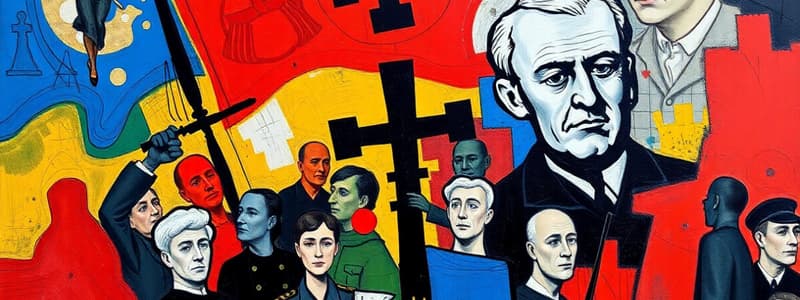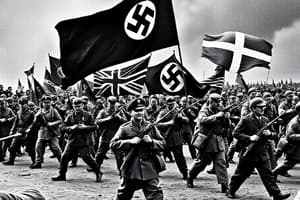Podcast
Questions and Answers
Which of the following was NOT a direct consequence of the war?
Which of the following was NOT a direct consequence of the war?
- The creation of the World Trade Organization (correct)
- Establishment of the United Nations to prevent future conflicts
- The systematic genocide of approximately six million Jews
- Widespread destruction of infrastructure and economies
What significant technological advancement played a crucial role in coordinating military efforts during the war?
What significant technological advancement played a crucial role in coordinating military efforts during the war?
- The mass production of steam powered tanks
- Advancements in radio and cryptography (correct)
- Implementation of satellite navigation systems
- Development of sophisticated mapping software
What significant geopolitical shift occurred as a direct result of the war?
What significant geopolitical shift occurred as a direct result of the war?
- The strengthening of all European colonial powers
- A decline in the global influence of China
- The emergence of the United States and Soviet Union as superpowers (correct)
- The establishment of a unified global government
The Marshall Plan was primarily designed to address what major issue in the aftermath of the war?
The Marshall Plan was primarily designed to address what major issue in the aftermath of the war?
Which innovation was NOT a significant technological advancement that impacted the conduct of the war?
Which innovation was NOT a significant technological advancement that impacted the conduct of the war?
Which treaty, imposed after World War I, is considered a significant factor contributing to the outbreak of World War II?
Which treaty, imposed after World War I, is considered a significant factor contributing to the outbreak of World War II?
Which of the following is NOT a common characteristic of fascism and Nazism in Europe during the pre-WWII era?
Which of the following is NOT a common characteristic of fascism and Nazism in Europe during the pre-WWII era?
What significant economic event of the 1930s exacerbated tensions and political instability, particularly in countries already struggling with economic hardship?
What significant economic event of the 1930s exacerbated tensions and political instability, particularly in countries already struggling with economic hardship?
What policy, adopted by some European powers towards aggressive nations, failed to deter further expansion, contributing to the start of World War II?
What policy, adopted by some European powers towards aggressive nations, failed to deter further expansion, contributing to the start of World War II?
Which event is considered the official start of World War II?
Which event is considered the official start of World War II?
What event drew the United States into World War II, marking a significant turning point in the conflict?
What event drew the United States into World War II, marking a significant turning point in the conflict?
Which of the following was NOT a major Allied power during World War II?
Which of the following was NOT a major Allied power during World War II?
Which of these statements best describes the overall impact of the Second World War?
Which of these statements best describes the overall impact of the Second World War?
Flashcards
The Holocaust
The Holocaust
The systematic genocide of approximately six million Jews by Nazi Germany.
Technology's impact on World War II
Technology's impact on World War II
The use of new weapons and technologies like radar, jet aircraft, atomic bombs, and improved tanks fundamentally changed how the war was fought.
UN's creation after World War II
UN's creation after World War II
The establishment of the United Nations was a direct response to the war, aiming to prevent future global conflicts and foster cooperation.
Division of Europe after World War II
Division of Europe after World War II
Signup and view all the flashcards
The Marshall Plan
The Marshall Plan
Signup and view all the flashcards
Treaty of Versailles
Treaty of Versailles
Signup and view all the flashcards
Rise of Fascism and Nazism
Rise of Fascism and Nazism
Signup and view all the flashcards
The Great Depression
The Great Depression
Signup and view all the flashcards
Appeasement
Appeasement
Signup and view all the flashcards
League of Nations' Failure
League of Nations' Failure
Signup and view all the flashcards
Imperialistic Ambitions
Imperialistic Ambitions
Signup and view all the flashcards
Invasion of Poland
Invasion of Poland
Signup and view all the flashcards
Allied Victory
Allied Victory
Signup and view all the flashcards
Study Notes
Causes of World War II
- The Treaty of Versailles, imposed on Germany after World War I, was a key factor. Harsh reparations, territorial losses, and restrictions on the German military fuelled resentment and instability.
- The rise of fascism and Nazism in Europe, characterized by extreme nationalism, expansionist policies, and totalitarian regimes, significantly destabilized the political landscape. Italy, Germany, and Japan implemented aggressive foreign policies.
- The global economic crisis of the 1930s, the Great Depression, exacerbated existing tensions and contributed to political instability, particularly in countries already struggling economically.
- Appeasement policies adopted by some European powers towards aggressive nations, like Germany, failed to deter further expansion, encouraging more belligerent actions.
- The failure of the League of Nations to effectively address global conflicts and maintain peace contributed to the outbreak of war.
- Imperialistic ambitions of European powers and Japan fueled conflicts in Asia and Africa.
Key Events of World War II
- The invasion of Poland by Germany on September 1, 1939, marked the official start of World War II.
- Following Poland, Germany invaded and swiftly conquered many European countries, showcasing its military strength.
- The Battle of Britain, a crucial air campaign between the Royal Air Force and the Luftwaffe, demonstrated the resilience of the British people and the importance of air power.
- The attack on Pearl Harbor on December 7, 1941, drew the United States into the war, marking a significant turning point.
- The Allied forces, primarily the United States, Great Britain, and the Soviet Union, launched numerous offensives across Europe and Asia, culminating in the defeat of the Axis powers.
- Key battles included the Eastern Front (the largest land battle in human history), the North African campaign, Guadalcanal, Iwo Jima, and the D-Day landing in Normandy.
Key Players and Alliances
- The Axis powers comprised Germany, Italy, and Japan, along with other smaller nations.
- The Allied powers included Great Britain, France, the Soviet Union, the United States, and China, among others.
- Alliances played a crucial role in shaping the war's outcome, involving complex political and military agreements.
Impacts of World War II
- The war resulted in a massive loss of life, including hundreds of millions of combat and civilian deaths.
- The war inflicted immense devastation upon infrastructure. Cities, towns, and industrial centers were destroyed, economies were shattered, and extensive human resources were expended.
- The Holocaust, the systematic genocide of approximately six million Jews by Nazi Germany, is a deeply disturbing aspect of the war.
- The war prompted the establishment of the United Nations, intended to prevent future global conflicts.
- The war significantly reshaped the international political landscape, leading to the decline of European powers and the rise of the United States and Soviet Union as superpowers.
- The war profoundly and lasting impacted global politics, economies, and social structures.
Technology and Warfare
- The development of new weaponry and technologies significantly affected the conduct of the war. Examples include radar, jet aircraft, atomic bombs, and improved tanks.
- Advances in communication technologies, such as radio and sophisticated coding/cryptography, were vital for coordinating military operations and intelligence gathering.
- Military technology advancements, including new aircraft and weapons, reflected the technological arms race inherent in the conflict.
Aftermath of World War II
- The establishment of the United Nations aimed to prevent future conflicts and foster international cooperation.
- The division of Europe into communist and capitalist spheres of influence set the stage for the Cold War.
- The war spurred the creation of numerous international organizations addressing economic and social issues.
- The Marshall Plan, a US aid program for rebuilding Europe, demonstrated the commitment to addressing the significant economic and social consequences.
- The war led to the redrawing of international borders and the emergence of new nations, influencing the geopolitical landscape.
Studying That Suits You
Use AI to generate personalized quizzes and flashcards to suit your learning preferences.




